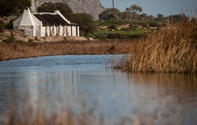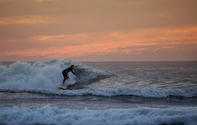Rumbling into the Bay
A few kilometres inland from Elandsbaai is the hamlet of Verlorenvlei, remnant of a farm that dates to the beginning of the 18th century. There was an abandoned horse-mill for flour milling and a few idyllic langhuisies with characteristic bo-en-onder doors, misvloere (dung floors), stone stoeps, single-casement windows with solid shutters and end gables with projecting chimney stacks.

The pride of the Cape’s peasant cottages. The sky was black and fog smoked from feathered wavelets. A thin wind blew from the west. In its current mood the vlei looked loch-like. Loch Verloor. I rumbled into Elandsbaai where two geese sauntered up the main road sporting the swagger of ownership.
Graffiti on a corrugated-iron wall read ‘Young American Gigolo’. At the Sonskyn Café a poster advertised Saturday’s - Aartappel Dans (a dance to mark the climax of the weekend’s Potato Festival). Elandsbaai is a sleepy Weskus dorp, the kind of spot that’s become a thing of nostalgia on the Cape’s more developed East Coast. But here two alarm bells were ringing. Locals block the vlei’s mouth to ensure fresh water for irrigation and to create a causeway.
As the estuary seldom breaks through to the sea, this results in increased siltation (leading to flooding), the expansion of reed beds and an increase in salinity, which affects the plant and fish community. What’s more, migrating harders can’t get through. I drove down to the crayfish factories where Derricks lower fishing bakkies into the surge.
The fish-shaped boats lay in rows – stub-nosed and seaworthy vessels ready for the start of the ‘kreef’ season. I parked beneath the crags of Baboon Point, shrouded in fog and streaked by horizontal rain coming off the sea.
A path led up the hill to a famous rock art site I’d last visited as a child. It’s a magical spot: the floor of the cave layered with millennia of human history, the walls with eland paintings and dozens of handprints. These prints, it is thought, represented communication with the ‘other world’. Shamans harnessed the supernatural power of the eland by using its blood as a binder in their paint. The handprints were touch points to enter the spiritual realm.
To my horror, I found that vandals had scratched over most of the paintings. I could almost feel the loss physically. What possesses Homo sapiens sometimes? In the age of the shi-shi guesthouse with matching potpourri, body lotion and bedside liqueur, it’s wonderful to still find no-nonsense ‘platteland’ establishments in the ‘Royal Hotel’ tradition. Hotel Eland is one of this endangered breed (my room, however, was spotless – a break with Royal Hotel tradition).
That evening the fog was thick as ‘ertjiesop’ (pea soup), so I ordered a double Captain Morgan and pine nut and settled down to delicious fried calamari. A radio echoed from somewhere in the adjacent cavernous hall, complete with table-tennis and pool tables, plastic flowers and indoor umbrellas.
I was alone in the hotel restaurant save for a Dutch couple who sang along to the radio: “I want to kiss you all over.” I was feeling a bit lost, a bit ‘stoksielalleen’, and couldn’t help marvelling at the emotions, the sense of belonging that the lonely Weskus brought out in even a casual visitor like myself. “Till the night closes in,” sang the Dutch.
Surfing Fun

Surfboard under arm I ran along the beach at dawn past two middens of Strandloper origin at the river mouth - evidence of shellfish feasts. A pod of surf rats up from Cape Town in a Kombi were smoking zol round a fire and waiting for their muscles to thaw before their next appointment with a wall of icy water.
Hardcore types with dreadlocks and woolly caps. I hobbled over mussel beds, my toes squelching on anemones; then leapt off a ledge, paddling fast through kelp beds. Soon the Atlantic anaesthetic took effect and I lost contact with hands and feet.
The upwelling of cold, nutrient-rich water was all very well for planktonic plant and animal organisms (vital in the rich food chain hereabouts), but decidedly unpleasant for humans pretending to be seals.
I had one endless ride, cleaving along a moving mountain; then just sat on my board taking in the beauty. Fog hid all memory of human intervention. The untrammelled Verloren Mouth opened a gap in the coast that stretched inland into white – a forgotten estuary, heavy with the mystery of lost histories.
During my brief stay I’d found there was lots still to verloor, plenty to preserve. The Palaeolithic record needed to be saved, the caves of antiquity guarded against vandals. Many langhuisies were in disrepair – their mud bricks melting back into Sandveld earth – and needed restoration.
The fragile ecology of the vlei had to be protected from short-sighted farmers who blocked the mouth or pumped too much water. But despite the challenges, the place had an undeniable charm; the breath of the past was still warm. A piece of my heart had been lost to Elands Bay and Verlorenvlei, I thought, as I opened a farm gate...
By Justin Fox
 The coast of South Africa offers amazing experiences out in the cool waters of the West Coast and the warmer waves of the eastern coast....
The coast of South Africa offers amazing experiences out in the cool waters of the West Coast and the warmer waves of the eastern coast.... Elands Bay is one of those spots Cape Town surfers and sandveld lovers talk about in hushed tones. It’s a place many want to keep a secret...
Elands Bay is one of those spots Cape Town surfers and sandveld lovers talk about in hushed tones. It’s a place many want to keep a secret...